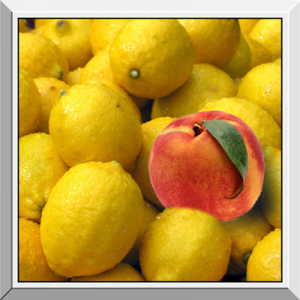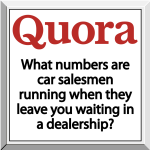 There are lots of lemons out there. Here’s how to find the peach.
There are lots of lemons out there. Here’s how to find the peach.
It’s probably the excitement of summer, but we’ve had a few inquiries lately from people looking to buy new (or new-to-them) cars. It’s a big step for anyone, and we’ve advised a lot of clients on it over the years. Here’s a reprint of our 2010 article summing all that advice up in one place. From buying from private parties or dealers to the “15 Questions You Must Ask Before Buying A Used Car” and even more, this article will give you everything you need to survive the Used Car Wars…
(Originally posted July 2010 by Tom Dwyer Automotive Services)
There is a reason that every vehicle on the market is being sold. The challenge of buying a used vehicle is finding the good one that fits your needs, is in your price range and is being sold for a good reason. You won’t find that perfect vehicle unless you are prepared to perform a methodical, logical search, or get very lucky.
First, determine the budget you have to work with. Whatever your budget, keep some  money in reserve for necessary and desired improvements to the car. Any vehicle you buy will probably need some repairs or routine maintenance. Buying a vehicle that needs repairs is fine, but buying a vehicle beyond repair is not. The under-$2,500.00 cars are the hardest market. There are plenty of $500.00 cars priced at $2,000.00, but very few $2,500.00 cars priced at 2,000.00. The starting price point for a good low end used vehicle is about $4500.00 and $6500.00 to $10,000.00 can buy a pretty nice used vehicle. Whatever your price range is; budget for repairs. Try to reserve at least 10% of the budget for needed repairs.
money in reserve for necessary and desired improvements to the car. Any vehicle you buy will probably need some repairs or routine maintenance. Buying a vehicle that needs repairs is fine, but buying a vehicle beyond repair is not. The under-$2,500.00 cars are the hardest market. There are plenty of $500.00 cars priced at $2,000.00, but very few $2,500.00 cars priced at 2,000.00. The starting price point for a good low end used vehicle is about $4500.00 and $6500.00 to $10,000.00 can buy a pretty nice used vehicle. Whatever your price range is; budget for repairs. Try to reserve at least 10% of the budget for needed repairs.
Second, select a quality model and range of years that fit your needs. Vehicle type, make and model are all matters of personal preference, but not all vehicles are created equal. Consult Consumer Reports, your friends, family and the service shop that will maintain your car for help determining which vehicles will meet those needs in the safest, most affordable manner over the longest period of time. I prefer to stay with Toyotas and Hondas as they are the most reliable vehicles out there. I think the Toyota Corolla is one of the best values on the planet. Narrowing your selection to one or two models will make you a better shopper and help you make an informed decision. The market value (i.e. Kelly’s Blue Book), features, handling/driving characteristics, and overall value of a deal will be easier to identify after becoming familiar with specific models and years.
Third, determine your search methods. Budget time and energy for the search. It is important that you browse advertisements in a consistent manner. Good vehicles don’t sit on the market long. Get the earliest edition possible of the publications that you are using. The first week of searching will seem like there are too many ads to deal with. Be patient. If you do your homework, the next week you will realize that there might be only a few new ads and the rest repeats from the previous week. If you see a vehicle of interest, check the information and call the seller for a phone interview as soon as possible.
Low mileage is everything! An older good make/model of car with low miles is most often a better value than a newer vehicle with high miles. Don’t buy the first car you see and don’t be pressured into a deal by comments about other buyers coming etc. Sales people (not excluding private parties) have statements that are universal. There are always other cars and other days to shop. Don’t buy any car until you feel it’s right. Cars purchased in haste are rarely good vehicles. A pre-purchase inspection is the best investment you can make. I really hate POST-purchase inspections… there is no way to undo the deal after an inspection shows the vehicle is economically challenged or not repairable. Most bad cars can be quickly and cheaply sorted out with a good pre-purchase inspection process.
Some good sources of car ads here in the Portland area are…
- The Oregonian
- Nickel Ads
- Auto Trader
- Willamette Week
- School and Community Newspapers
- Bulletin Boards at schools, businesses, or retirement homes
- Friends
- The Internet
Be careful with Craig’s List! We see a lot of bad cars from CL!
CarFax can be useful, but not necessarily complete.
You should consider getting a CarFax report for any used vehicle you’re considering buying, but be careful… it’s not necessarily a complete report on the vehicle. CarFax can only report data that has been reported to it, so it could have major gaps. Don’t unquestioningly trust a CarFax report!
Use it for…
- Title transaction records– Who has owned the vehicle matters; this information is recorded every time the car changes owners, and this is one of the strengths of CarFax reports.
- Length of ownership– Good vehicles have few owners, each keeping it for a reasonable time. Cars that change hands frequently, either between private parties or dealers, usually have some serious issue that’s being passed around.
- Geographical history– Where the car spends most of its service life can make some mechanical issues more likely. Good vehicles don’t need to cross state lines usually.
Don’t use it for…
- Accident history– CarFax will reveal any accidents it know about, but there’s no way to know if the vehicle was wrecked, repaired, and never reported.
- Mechanical issues– CarFax has no information on the current mechanical condition of the vehicle.
Buying from a major new car Dealer with used inventory.
 Dealer inventory is not acquired from little old ladies, meticulous autophiles, or benevolent philanthropists. They probably won’t offer you the best deal up front just because it’s you. They need to sell all of their inventory, not just the two best cars on the lot.
Dealer inventory is not acquired from little old ladies, meticulous autophiles, or benevolent philanthropists. They probably won’t offer you the best deal up front just because it’s you. They need to sell all of their inventory, not just the two best cars on the lot.
Dealers are not my first choice, but their ability to take your old car in on trade and finance your new one makes their convenience very attractive. If you decide to go with a dealer, stay with the major dealers who sell both new and used cars and stay on their main new car lot, as opposed to the used car satellite lots. Be careful with small dealers and the used car lots as they rely on auctions, rather than trade-ins and lease-returns for their inventory. Auctions are where dealers trade their junk. Good vehicles don’t cross state lines and don’t go to auction.
Don’t spend a lot of time with any one salesperson. If they don’t have a car that fits your predetermined needs and price range, move on. If one of their cars interests you, ask them a few quick questions. Is the price firm? Has it ever been in an accident? Do you have the CarFax report? Does it have any remaining warranty? Can I have it inspected by an independent ASE Certified Master Technician? It is common for a dealer to know nothing about a vehicle, with knowledge comes responsibility.
The first questions that the dealer will probably ask you are, “Do you have a trade in?” and “Are you going to finance?” Tell them you have no trade in (even if you do) and that you are interested in their financing (even if you are not). If you have a trade in keep the deals separate. Work out the best deal on the car first, and then ask about trade values. The dealer may be willing to negotiate a lower vehicle price if there is an assumption of profit from financing. Once the price of the used vehicle has been established, then introduce any other variables. The dealer will want to blend any and all the deals together and have you just focus on the monthly payment. There is more to the cost picture than the singular monthly payment.
If the dealer does have a vehicle that is of interest to you, make sure you have it inspected by a qualified, thorough, neutral party. The term “certified” used car doesn’t do much for me. I prefer an independent inspection and report, rather than the empty word “certified.” The dealer will usually let you have the vehicle inspected after signing paperwork. Be careful, the paperwork might obligate you to buy the vehicle anyway. Require the paperwork to give you the right to negotiate after the inspection or decline depending upon mechanical condition. If they won’t let you have it checked or you’re not comfortable with the contract, walk away. If the car checks out okay and you can reach mutually satisfactory terms, congratulations.
Remember that the dealer does this for a living and knows the game much better than you do. Time is on their side and they know that you might get burnt-out and buy anything in haste. What more could they want?
Buying from a Private Party
Private party sales potentially result in the best values but require much more commitment from the buyer. While it is easy to buy from a dealer, finding a good value in terms of both in dollars and vehicle quality requires greater effort. Professionals don’t leave money on the table. A professional is more likely to sell you a marginal vehicle for a good price, or a good vehicle for a marginal price than a good vehicle for a good price.
Private party sales are considered buyer-beware sales: you buy it, it’s yours. Therefore, make sure you’re dealing with a true private party and not a car salesman without a dealer’s license. In Oregon, people who sell cars for profit are required to have a license and with this license comes certain legal obligations. Similarly, beware of sellers who are not the titled owners of the vehicle in question. There is an increasing population of people that sell cars for profit but do not have a dealer’s license. Make sure your private party seller is a private party.
When responding to a private party advertisement, here are the 15 Questions You Must Ask Before Buying a Used Car:
- How many miles are on the odometer?
- Is your name on the title? Is it an “R” titled vehicle or reconstructed titled vehicle? Is the title clear?
- Are the tags current? When do they expire?
- How long have you owned the vehicle (Both time and miles)?
- Where did you purchase it?
- How was it driven (for long or short trips, in the city or in the country)?
- Who drove it (a 16 yr. old / a 90 yr. old)?
- Who performed the maintenance and do you have the receipts?
- Has the vehicle ever been damaged or in an accident? If so, how much was the repair and where was it performed?
- Why are you selling such a “great” vehicle?
- What do you know that needs repair on the vehicle?
- Is the price firm?
- How are the: paint, body, tires, glass, accessories?
- Does the AC work?
- Can I have the vehicle checked by an ASE Certified Master Technician?
Write down the answers to your questions so you can verify the truthfulness of the owner’s answers when you arrange to inspect the car in person. If you don’t get a good feeling about the owner or the information they’ve given, move on and don’t waste your time seeing the vehicle in person. I can eliminate 80% of vehicles from the ad itself or the phone call.
If you are satisfied with the owner’s responses to your questions, try to see the vehicle as soon as possible. Bring your notes from the phone interview so you can verify each response and dress for preliminary inspection.
The Preliminary Inspection
Remember that no one buys a new car, maintains it to perfection and turns around and sells it long before the end of its realistic service life without a good reason.
Check the car to see if it has been warmed up before you have arrived. Place your hand on the hood near the radiator and feel if it’s warm. If it feels warm, the car has probably been driven recently. It is good to observe a cold start to check for possible problems not apparent with a warm engine. Knocking, ticking, smoking, hard starting, stalling, poor cold performance, may be signs of serious problems and if these symptoms disappear when warmed up, these problems may not even be noticed in a professional inspection.
Inspect the body. Has the car just been detailed? Is it too clean to believe? Check the body panels for dents and paint problems. Check the uniformity of the body seams and the paint color-match and texture-match between panels. All the body panels and doors have VIN stickers that should match. Check the glass and the headlight lenses. Check for any paint on rubber moldings or over-spray. Check the tires for match of brand and wear. Check the wiper blades. Look in the trunk. Check for moisture or any signs of mold, a spare tire and the original toolkit. Pull up any carpet or matting to see the trunk surfaces. If you smell mold take that as a sign the vehicle has water leaks that may be an expensive problem to fix.
Under the Hood
Check for the under-hood information and VIN stickers. There are usually two or more stickers affixed to the underside of the hood, on the panel over the radiator or on the inner fenders. These stickers give information about emissions, tune-up, and other important specifications. If they are missing, the hood or other body parts may have been painted or replaced. Check any seams, body panel junctions or fasteners for signs of work. Look at the belts and hoses and ask the owner if they are original. Ask if the seller knows if the vehicle has a timing belt and when it was last replaced. Look at the air filter if possible. Inspect the battery and its cables. Is it clean or crusty? Is it the original? If the under hood area is spotless ask it the engine has been steam cleaned. Oil leaks can be temporarily hidden with a good engine clean.
Check the Fluids
Pull the engine oil dipstick and check the oil condition. It should be full and clean. Ask the owner when the last change was and the frequency of changes in the car’s history. Non-synthetic oil should be change every 3,000 to 4,000 miles or 4-6 months whichever comes first. If the oil was just changed it should be nice and clean. If the oil is 3,000 miles old it will be dark but should never be black. Ask the owner who changed the oil and what brand and viscosity of oil was used.
With the engine cold, open the radiator cap and inspect the coolant. It should be nice and green (or in some imports red), not brown or rusty looking. Ask the owner if they know when the cooling system was last serviced and do they know how old the thermostat is.
Check the power steering fluid. It should be clean and look either clear or pink, not metallic, and should not have a strong odor.
If possible, check the brake hydraulic fluid. It should be clean and transparent, not dark and dirty. Ask the customer if the brakes have been worked on and if they have serviced the brake fluid. Brake fluid should be replaced every 2-3 years or when brake work is performed. This is especially critical on cars with anti-lock brakes as an ABS brake problem can cost thousands of dollars.
With the engine warm, check the transmission fluid (automatics only). Pull the dipstick the fluid should be nice and pink. The level should be proper, no yellow or dark color and no nasty smell. There should not be any metallic particles in the fluid.
Check for Leaks
Puddles and/or stains under the car are a bad sign. Look for excessive residue of oil or other fluids on the engine, transmission or other underhood components. Also as mentioned, you should note if the underside or engine compartment is TOO clean to be believed. Was the engine just cleaned to hide a leak?
The Road Test
Plan to drive the vehicle for at least 30 to 60 minutes on a variety of road conditions and at various speeds. Before the car is started, turn the key to the on position and check that all the warning lights are illuminated. This is called bulb-check mode. Make sure that warning lights such as Check Engine, oil pressure, emissions, ABS, air bag and engine control all are working and not disabled to hide a problem. Turn the steering wheel back and forth to check for free-play. There should not be a lot of play in the steering. Check the brake and clutch (if applicable) pedal height and response.
Start the car. It should start smoothly and easily. You should not have to depress the gas pedal on a fuel injected car to start it. There should be no unusual noises or any visible smoke (light vapor from the tail pipe is normal depending on the weather/temperature). Once the vehicle is started, place you foot on the brake and place the transmission (automatic) in drive and then reverse at a standstill. There should be no hesitation between park and drive or park and reverse, the engagement should be firm and quick.
Place the transmission back into park and check all gauges and vehicle functions. Do the gauges work, does the radio/tape/cd player work? Do the odometer numbers line up straight across the bottom? Is the odometer colored green or red from tamper-indicator? Do all the driver’s controls work? Check the horn, vents, blower, defroster, seat controls, dash lights, park brake, turn signals, remote mirrors etc. and adjust them to your needs. Now you are ready to drive the car.
Try to drive the vehicle on as many road conditions as possible. Find a good long, uphill climb (like HWY 26 to the Zoo) and watch the temperature gauge if equipped. The temperature gauge should not rise on a long uphill pull. Find a bumpy road to check for rattle and clunks. Apply the brakes firmly from several speeds. The vehicle should stop quickly and evenly in a straight line. Pull or pedal/steering wheel pulsation are signs that brake work is needed. The brake pedal should feel tall and firm at all times. If the car is equipped with anti-lock brakes a quick panic stop should be attempted. The wheels should not skid and the ABS related warning lights should not illuminate. The brake pedal will ratchet/vibrate noticeable during the operation of ABS brakes when the system is trying to prevent wheel skid. (This should not be confused with brake pulsation or vibration from the operation of the standard brake system caused by warped rotors and/or drums.) Make sure the AC works, it is really expensive to fix it. Set and test the cruise control (if equipped) to make sure it will work properly. Accelerate firmly to check for performance problems. The vehicle should not hesitate, ping, stall, smoke or anything other than go like heck.
Once back from the road test make sure to keep an eye and nose on any under hood smells or smoke.
The Emissions Test
Now with enhanced emissions testing in Oregon, you must be even more careful about purchasing a vehicle that might not pass. There is no waiver for this test. ALL CARS MUST PASS. It can be very expensive to make a non-compliant vehicle pass. Before you buy any vehicle, take it to one of the test centers and have it tested. DEQ tests are free of charge. It is the certificate that you pay for. A little inconvenience could save you a lot of money.
If the vehicle has passed the test to this point then it’s time to take the vehicle to a professional for inspection. If the vehicle is not checking out to you specifications, it probably won’t pass a professional’s either.
In summary
Go with your instincts and experience. Use all your senses including your sense of smell. Put in the time and energy required to perform a logical search and you will be more likely to find a good vehicle being sold for a good reason.
A good used car will demonstrate:
- Long-term or original ownership.
- As low as mileage as you can afford.
- A reasonable sales price.
- A history of appropriate, professional maintenance, with documentation.
A good seller will demonstrate:
- A good reason for selling the vehicle.
- Proof of professional maintenance.
- Attention to details about vehicle maintenance.
- Willingness to have the car inspected.
- Honest answers to all your questions about the vehicle.
- A feeling of trust and openness about the circumstances surrounding the sale.












